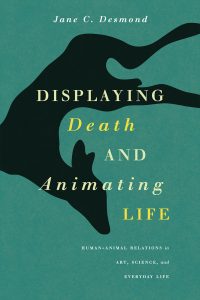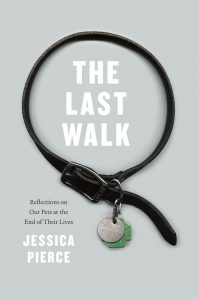A Very October Reading List
In numerous cultures, it is believed, even celebrated, that with the arrival of autumn, the veil between the living world and what lies beyond grows thin—from Día de los Muertos, or Day of the Dead, in Mexico and Spain; to Fed Gede, or Festival of the Ancestors, in Haiti; to Yu Lan, or the Hungry Ghost Festival, in China; to Halloween in the United States. While each holiday is nuanced and unique, October welcomes traditions around the globe that center on mortality. As spirits, ancestors, ghosts, and ghouls parade into our earthly realm, we offer a reading list that will invite you to consider death and dying from a wide variety of vantage points.
Is the Cemetery Dead? by David Charles Sloane
In modern society, we have professionalized our care for the dying and deceased in hospitals and hospices, churches and funeral homes, cemeteries and mausoleums to aid dazed and disoriented mourners. But these formal institutions can be alienating and cold, leaving people craving a more humane mourning and burial process.
Is the Cemetery Dead? gets to the heart of the tragedy of death, chronicling how Americans are inventing new or adapting old traditions, burial places, and memorials. In illustrative prose, David Charles Sloane shows how people are taking control of their grief by bringing their relatives home to die, interring them in natural burial grounds, mourning them online, or memorializing them streetside with a shrine, ghost bike, or RIP mural. Today’s mourners are increasingly breaking free of conventions to better embrace the person they want to remember.
“A fascinating glimpse of new and evolving mourning rituals in American culture. As the son of cemetery managers, Sloane brings personal experience and knowledge to an otherwise academic history of burial methods, mourning, and memorials. . . .This is a great overview of mourning rituals in modern American culture.” Publishers Weekly
Displaying Death and Animating Life: Human-Animal Relations in Art, Science, and Everyday Life by Jane C. Desmond
The number of ways in which humans interact with animals is almost incalculable. From beloved household pets to the steak on our dinner tables, the fur in our closets to the Babar books on our shelves, taxidermy exhibits to local zoos, humans have complex, deep, and dependent relationships with the animals in our ecosystems.
Desmond conducts research on-site at major museums, taxidermy conventions, pet cemeteries, and even at a professional conference for writers of obituaries. She goes behind the scenes at zoos, wildlife clinics, and meetings of pet cemetery professionals. We journey with her as she meets Kanzi, the bonobo artist, and a host of other animal-artists—all of whom are preparing their artwork for auction. Throughout, Desmond moves from a consideration of the visual display of unindividuated animals to mourning for known animals, and finally to the marketing of artwork by individual animals.
“This book is a unique source of ‘food for thought’ about the comparative value of human and nonhuman lives, and ultimately, the appropriate and inappropriate ways of displaying animal deaths. Through a series of selected anecdotes and case studies, the author takes a multidisciplinary approach to understudied areas within human-animal relationships, including museum exhibitions, burial and mourning practices, and artworks made by animals. A critical aspect of this work is the careful analysis of the various emotional and artistic expressions of animals’ afterlife across different human societies. . . . The overarching implications of this book are extensive, as they address the meaning of a diverse range of lives. Recommended.” Choice
Subject to Death: Life and Loss in a Buddhist World by Robert Desjarlais
With Subject to Death, Desjarlais provides an intimate, philosophical account of death and mourning practices among Hyolmo Buddhists, an ethnically Tibetan Buddhist people from Nepal. He studies the death preparations of the Hyolmo, their specific rituals of grieving, and the practices they use to heal the psychological trauma of loss. Desjarlais’s research marks a major advance in the ethnographic study of death, dying, and grief, one with broad implications. Ethnologically nuanced, beautifully written, and twenty-five years in the making, Subject to Death is an insightful study of how fundamental aspects of human existence—identity, memory, agency, longing, bodiliness—are enacted and eventually dissolved through social and communicative practices.
“A detailed, insightful, and at times moving ethnography of rituals around death and dying among ethnically Tibetan Hyolmo Buddhists in Nepal. Desjarlais provides rich descriptions of the Hyolmo’s multistage approach to dying, from the prayers and presence of lamas around a dying individual to help the person leave the world without any attachments to the construction of the funeral pyre and search for sacred relics or images among the bones. As he describes each stage of this intricate rite, Desjarlais reflects on the meaning of the ritual, which connects individuals facing loss to universal human emotions. In addition, he looks at the ways in which the rites and rituals around dying reflect the Buddhist world view of impermanence and rebirth. This balance between attention to the particular and reflection on the universal is what makes this book so rich.” Choice
Arts of Dying: Literature and Finitude in Medieval England by D. Vance Smith
Covering the emergence of English literature from the Old English to the late medieval periods, Arts of Dying argues that the problem of how to designate death produced a long tradition of literature about dying, which continues in the work of Heidegger, Blanchot, and Gillian Rose. Philosophy’s attempt to designate death’s impossibility is part of a literature that imagines a relationship with death, a literature that intensively and self-reflexively supposes that its very terms might solve the problem of the termination of life. A lyrical and elegiac exploration that combines medieval work on the philosophy of language with contemporary theorizing on death and dying, Arts of Dying is an important contribution to medieval studies, literary criticism, phenomenology, and continental philosophy.
“Arts of Dying is an ambitious study that offers a philosophically and theoretically driven analysis of the treatment of death and dying in a wide range of Old and Middle English texts. Death, as they say, is one of the two great topics of all literature, but Smith offers a compelling and highly original treatment of it. The book is positively breathtaking and provides new and important insights throughout.” Larry Scanlon, author of Narrative, Authority, and Power: The Medieval Exemplum and the Chaucerian Tradition
The Last Walk: Reflections on our Pets at the End of their Lives by Jessica Pierce
With The Last Walk, Jessica Pierce makes a forceful case that our pets, and the love we bear them, deserve better. Drawing on the moving story of the last year of the life of her own treasured dog, Ody, she presents an in-depth exploration of the practical, medical, and moral issues that trouble pet owners confronted with the decline and death of their companion animals. Pierce combines heart-wrenching personal stories, interviews, and scientific research to consider a wide range of questions about animal aging, end-of-life care, and death. She tackles such vexing questions as whether animals are aware of death, whether they’re feeling pain, and if and when euthanasia is appropriate. Given what we know and can learn, how should we best honor the lives of our pets, both while they live and after they have left us?
“Decisions about how to treat an animal toward the end of her or his life are among the most difficult we have to make and it’s our responsibility to do the best we can. Our companions trust that we will have their best interests in mind. In The Last Walk, Jessica Pierce considers all of the hard questions about sick and old animals. She seamlessly weaves in personal stories with scientific research to provide readers with an incredibly valuable guide–a must read–about when and how to end an animal’s life in the most humane way possible. I learned a lot from reading this book, and I know others will as well.” Marc Bekoff, author of The Emotional Lives of Animals
All of these books are available now from our website or your favorite bookseller.




